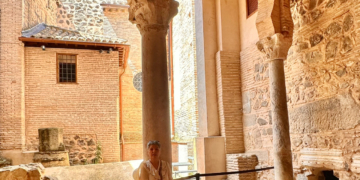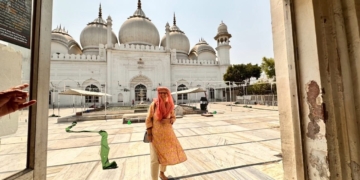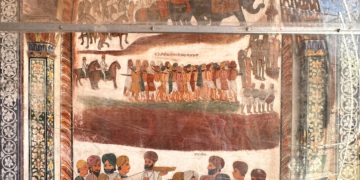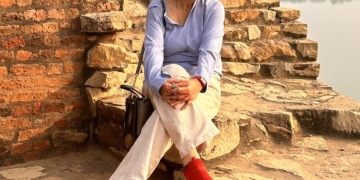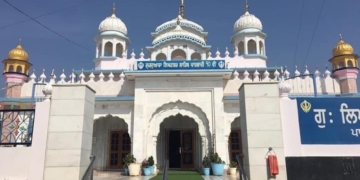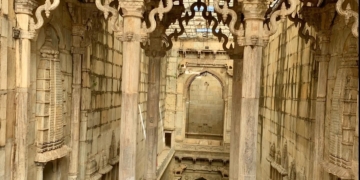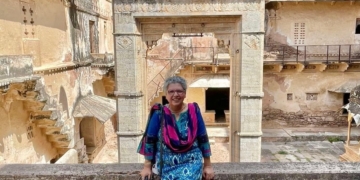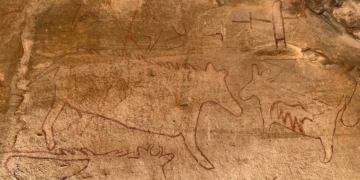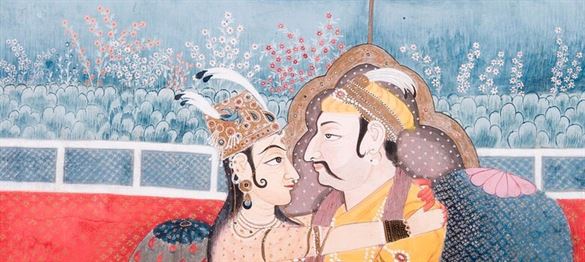Whatever the truth, the impact this Persian refugee had on emperor Jahangir cannot be denied.
— Read on scroll.in/article/803818/was-nur-jahan-a-scheming-temptress-or-just-an-independent-woman-historians-couldnt-fathom
Was Nur Jahan a scheming temptress or just an independent woman who historians couldn’t fathom?
Whatever the truth, the impact this Persian refugee had on emperor Jahangir cannot be denied.
by Rana Safvi
Published Mar 08, 2016 · 01:30 pm

Nur Jahan and Emperor Jahangir. Opaque watercolor, gold, and silver on paper. Los Angles County Museum of Art | Photo courtesy: LCMA
She was the 35-year-old widow of a man who had fallen out of favour with the Mughal emperor when she caught the eye of Jahangir. Within years, Mehr-un-Nisa, or Nur Jahan as she is known in history, rose to become the most powerful woman in the Mughal empire – coins were minted in her name, she enacted legislation, issued edicts, interacted with foreign traders and determined the empire’s policy.
But that is not the reason why I want to talk about her today, on Women’s Day. Nur Jahan saved the life and dignity of her husband – it is her bravery in this context that makes her my woman of the day.
Born in Kandahar to impoverished Persian parents fleeing Tehran in search for better opportunity in the Mughal empire, Mehr-un-Nisa grew up to be an extraordinarily beautiful and accomplished young girl. She was married at the age of 16 to Ali Quli Istajlu, who too was a refugee from Persia who had joined Khan-i-Khanan Abdur Rahim – a senior nobleman and poet popularly known as Rahim – in Emperor Akbar’s court.
Ali Quli later fought for Prince Salim (the future Jahangir) in a campaign against the Kingdom of Mewar and was awarded the title of Sher Afghan for his bravery. However, he fell out of favour with the prince after Salim rebelled against Akbar (the falling out had nothing to do with Mehr-un-Nisa). In 1605, after Akbar died, and Jahangir became emperor, he pardoned Ali Quli but transferred him far away, to Burdwan, in Bengal. Two years later, Ali Quli was killed in a fracas with Qutbuddin Khan, the Governor of Bengal.
The many romantic stories we hear of how the young Salim fell in love with Mehr-un-Nisa and eventually got Sher Afghan murdered, like many of its genre, are latter day fabrications that medieval Indian history expert Satish Chandra said serious historians do not accept.
Star of the harem
After Sher Afghan’s death, the young widow, and her daughter Ladli, were brought to Agra. Mehr-un-Nisa was made an attendant to Salima Sultana Begum, Akbar’s wife, and Jahangir’s stepmother. She lived in the Mughal harem for four years during which time she used her skill in embroidery and stitching to become a very popular designer for the Mughal ladies. She dressed very simply herself – mainly in whites – but fashioned brightly coloured brocades, tissues and silks for the ladies of the harem. Her designs were much sought after and often set the fashion trends. To her goes the credit for inventing the Dudámí (flowered muslin) for peshwáz (gowns open in the front), pánchtoliah for oṛhnís (a new design for veils), bádlah (embroidery with metal strips), kinárí (lace), and farsh-i-chandaní (white cloth for floor covering). She is also credited with designing gold ornaments with elegant new patterns.
In 1611, Jahangir happened to meet her at Meena Bazar – a new year fair started by Akbar in which the emperor was the only male present while noblewomen, princesses and other female members of the royal harem exhibited brocades, exquisite silks, fine muslins, bejeweled turbans and the like. Jahangir fell in love with her, proposed immediately, and they were married on May 25 of the same year. She was his 18th and last wife. Jahangir gave her the title of Nur Mahal or light of the palace and later Nur Jahan or light of the world. She was also given the title of Badshah Begum.
Poet and hunter
Mughal ladies were highly accomplished and studied art, literature, philosophy, and religious studies with learned tutors. Nur Jahan was no exception, but she was a brilliant conversationalist too. She composed Persian poems occasionally under the pen name of Makhfí, or the concealed one, a pseudonym also used by other female writers in the Mughal court like Salima Sultana Begum and Aurangzeb’s daughter Zebunnisá Begum.
Mughal women were trained in basic warfare and knew how to use swords and other weapons. Nur Jahan was a crack shot, and often accompanied Jahangir on tiger hunts. In his memoirs, Tuzuk-e-Jahangiri, the emperor described one such occasion in 1619:
My huntsmen reported to me that there was in the neighbourhood (of Mathurá) a tiger, which greatly distressed the inhabitants. I ordered his retreat to be closely surrounded with a number of elephants. Towards evening I and my attendants mounted and went out. As I had made a vow not to kill any animal with my own hands, I told Núr Jahán to fire my musket. The smell of the tiger made the elephant very restless, and he would not stand still, and to take good aim from a howda is a very difficult feat. Mírza Rustam, who after me has no equal as a marksman, has fired three or four shots from an elephant’s back without effect. Núr Jahán, however, killed this tiger with the first shot.
He described another occasion in which she killed four tigers with six shots:
She shot two tigers with one shot each and knocked over the two others with four shots. In the twinkling of an eye she deprived of life the bodies of these four tigers. As a reward for this good shooting I gave her a pair of bracelets of diamonds worth 100,000 rupees and scattered 1,000 ashrafis over her.
Nur Jahan had a refined cultural taste and ably assisted Jahangir in his pursuit of art and painting. Her mother, Asmat Begum, had discovered attar or essence of roses, but the credit of distilling and popularising it goes to her. Apart from this, she took care of orphans, especially girls, and is estimated to have arranged the marriages of, or provided for, five hundred such girls.
She was a great patron of architecture too, and built many beautiful palaces, gardens and mosques. The tomb she built for her father Mirza Ghias Beg (who was later given the title Itimad-ud-Daula or pillar of the state by the emperor) in Agra is one of the most exquisite examples of Indo-Persian architecture, and provided inspiration for the Taj Mahal. She also built the Pathhar Masjid mosque at Srinagar.

The tomb of Nur Jahan’s father, Itimad-ud-Daula, in Agra is said to have inspired the Taj Mahal. (Photos courtesy: Daniel Mennerich).
An emperor besotted
It has been implied that Nur Jahan’s dominant role during Jahangir’s reign led to rebellion and disaffection amongst nobles especially with his third son Prince Khurram or Shah Jahan. While some historians have painted her as an ambitious, scheming temptress who took advantage of Jahangir’s love for wine and opium to take over the reins of the empire, others like professor Satish Chandra have argued that the prejudice against Nur Jahan possibly reflected “the deep-seated anti-feminist bias of many contemporary historians which has often been repeated uncritically” by others.
However, her impact on Jahangir’s life can’t be denied. In his memoirs, the emperor said:
“Before I married her, I never knew what marriage really meant… She gradually reduced the quantity of wine I took, and guarded me against unsuitable food and improper things”.
When Jahangir fell sick, which he did often in the latter part of his reign, Nur Jahan monitored his health and took over the reins of government with his permission. Except for the khuṭbah (prayer for the reigning monarch), she possessed all the privileges of a ruler. Farmans or edicts were issued in her name and grants were conferred under her seal. From 1623-27 AD coins were also struck in her name bearing the words:
Ba hukm Shah e Jahangir yaft sad zewar (front)
By order of the King Jahángír, gold has a hundred splendours added to it
Za naam e Nur Jahan Badshah Begum zar (on reverse)
By receiving the impression of the name of Núr Jahán, the Queen Begum.
She is the only Mughal woman in whose name coins were struck. She would even appear with Jahangir for jharokha darshan, a tradition that Akbar started in which the emperor would show himself at the window after dawn prayers every day to give the common people an audience.
Her father and brother rose to be important nobles during the reign of Jahangir but it was primarily because of their own abilities. As Jahangir said in his memoirs:
“… On the basis of seniority in service, extent of sincerity and experience in the affairs of government, I exalted Itimad-ud-Daula to the high post of Wizarat of the Dominion”.
Indian historian Prof Nurul Hasan pointed out that the rise of Itimad-ud-Daula and his family took place after 1616 when Nur Jahan was not so active in politics. She only stepped into the limelight in 1622 when Jahangir’s health was failing, his son Shah Jahan was in open rebellion, and her father was no longer alive to guide affairs. Ambitious nobles tried to take advantage of this situation but they underestimated her grit.
Woman in battle
In 1626, the emperor was weakened by ill health and Nur Jahan appointed as prime minister, her brother Asaf Khan. An important courtier and Mughal general Mahabat Khan felt slighted. He was considered a potential threat by some sections. Perhaps to put him in his place, Mahabat Khan was asked to render accounts, and to surrender war elephants he had captured during a campaign. A troop of soldiers was sent to escort him to court. But instead of meekly accompanying them, he came with a trusted body of Rajput warriors and seized the emperor as the royal camp was crossing the river Jhelum on its way to Kabul.
Mutamad Khan, the author of Iqbalnama-e-Jahangiri, who was present there, wrote:
After Núr Jahán had crossed the river, and reached the house of her brother, she summoned all the chief nobles, and addressed them in reproachful terms. “This,” she said, “has all happened through your neglect and stupid arrangements. What never entered into the imagination of any one has come to pass, and now you stand stricken with shame for your conduct before God and man. You must do your best to repair this evil, and advise what course to pursue.”
Nur Jahan joined the battle that ensued to release Jahangir from Mahabat Khan’s clutches. Despite a tactical disadvantage, the superior force of the enemy, the deep gushing water and severe injuries to her elephant, she kept shooting arrows at the enemy. But though she fought bravely, attempts to rescue the emperor proved fruitless.
She returned to Lahore and thought of other ways to rescue Jahangir. She had realised by then that she was powerless while separated from the emperor as both their lives were in danger. On Jahangir’s invitation, she joined him in Kabul. Mahabat Khan was now at ease as the emperor was reconciled with him, but Nur Jahan was planning their escape.
Said Mutamad Khan, in the Iqbalnama-e-Jahangiri:
Núr Jahán Begam worked against him both in private and in public. She maintained a number of followers, and attached them to herself by money and promises.
Within six months, taking advantage of Mahabat Khan’s weaknesses, Nur Jahan was able to wean away most of the nobles from his side. Realising that his position was precarious, Mahabat Khan fled from the court and later joined Shah Jahan who was biding his time till he ascended the throne. Nur Jahan’s sharp intellect, cool head and courage led her to her greatest victory, the defeat of Mahabat Khan. However, her triumph was short-lived as Jahangir died soon after in Lahore. The year was 1627.
Nur Jahan gracefully retired from public life once Shah Jahan became emperor, and died in Lahore in 1645. She was 72. She was buried in a red sandstone tomb she had built for herself in Shahadra Bagh, Lahore, a short walk away from her husband’s last resting place.

